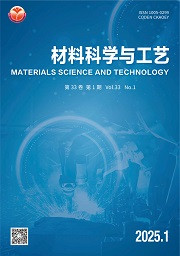| 引用本文: | 黄小明,雷敏,李学文,李玉龙.表面粗糙度对TiAl/AgCu/TiAl钎焊质量的影响[J].材料科学与工艺,2019,27(4):1-7.DOI:10.11951/j.issn.1005-0299.20180178. |
| HUANG Xiaoming,LEI Min,LI Xuewen,LI Yulong.Effects of surface roughness on the TiAl/AgCu/TiAl brazing quality[J].Materials Science and Technology,2019,27(4):1-7.DOI:10.11951/j.issn.1005-0299.20180178. |
|
| 摘要: |
| 为探究表面粗糙度对钎焊质量的影响,在优选的钎焊温度870 ℃和保温时间5 min条件下,以AgCu合金为钎料,进行TiAl合金的真空钎焊,研究了表面粗糙度与磨痕方向对钎料润湿铺展、钎焊接头界面组织、力学性能的影响.采用扫描电镜、能谱分析、光学显微镜和万能材料试验机等分析测试手段,对钎焊接头的组织与力学性能进行分析.结果表明:AgCu钎料在各向异性的TiAl基板表面润湿铺展时会受表面特征影响,沿着特定的方向优先铺展,当基板表面不具各向异性特征时,钎料润湿铺展近似为圆形;表面粗糙度Sa=0.103 μm的基板,钎焊接头的平均剪切强度最优,达到323 MPa,而表面粗糙度Sa=0.133 μm的基板,接头平均剪切强度为245 MPa,钎焊接头强度均方差最大. |
| 关键词: 表面粗糙度 表面形貌 磨痕方向 界面组织 润湿铺展 |
| DOI:10.11951/j.issn.1005-0299.20180178 |
| 分类号:TG454 |
| 文献标识码:A |
| 基金项目:国家自然科学基金资助项目(51665038);江西省自然科学基金重点项目(20171ACB21011);江西省主要学科学术带头人项目(20182BCB22001). |
|
| Effects of surface roughness on the TiAl/AgCu/TiAl brazing quality |
|
HUANG Xiaoming, LEI Min, LI Xuewen, LI Yulong
|
|
(Mechanical & Electrical Engineering School, Nanchang University Key Lab for Robot & Welding Automation of Jiangxi Province, Nanchang 330031, China)
|
| Abstract: |
| In order to study the effect of surface roughness on brazing quality, TiAl alloy was brazed with AgCu filler metal in a vacuum-furnace at the preferred parameters of 870 ℃ for 5 min.The effects of surface roughness and topographyic characteristics on the wetting and spreading of process, the microstructure, and bonding strength of the joints were investigated. The microstructure of the brazed joints were analyzed by scanning electron microscope, energy dispersive spectrometer, optical microscope, and universal material testing machine. Results revealed that the spreading was preferential when AgCu molten metal spreaded over an anisotropically microstructured TiAl surface. When the surface of the substrate was not anisotropic, the spreading morphology was approximately a perfect circle. The maximum average shear strength of 323 MPa was obtained when the substrate surfaces roughness Sa=0.103 μm. The average shear strength of the joints was 245 MPa when the substrate surfaces roughness Sa=0.133, and the RMSE of the shear strength was the largest. |
| Key words: surface roughness surface topography topographic characteristics interfacial microstructure wetting and spreading |






